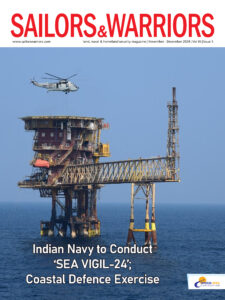 BRAHMOS, the deadliest supersonic cruise missile in the world that can be integrated on almost all platforms and capable of operating from across the spectrum of war, has great potential to become India’s major weapon export in the coming decades, says Dr. Sudhir Kumar Mishra, Distinguished Scientist & Director General (BrahMos), DRDO, Ministry of Defence, CEO & MD BRAHMOS Aerospace, in an exclusive interview with Aeromag. Excerpts from the interview:
BRAHMOS, the deadliest supersonic cruise missile in the world that can be integrated on almost all platforms and capable of operating from across the spectrum of war, has great potential to become India’s major weapon export in the coming decades, says Dr. Sudhir Kumar Mishra, Distinguished Scientist & Director General (BrahMos), DRDO, Ministry of Defence, CEO & MD BRAHMOS Aerospace, in an exclusive interview with Aeromag. Excerpts from the interview:
In the context of IDEX, in Abu Dhabi, shall we start off by seeking your perspectives on the scope and intent of BrahMos Aerospace garnering a big chunk of missile export market in the Arabian Gulf, Middle East and South East Asian countries? How do you respond to the reports about BrahMos being sought after by the Philippines and some other nations in the ASEAN region, as well as some South American, East European and African countries?
BRAHMOS supersonic cruise missile is a weapon of strategic importance and Government of India would take appropriate decision to export this missile system to any country as dictated by its diplomatic and strategic policies. I don’t want to divulge anything on the talks and discussions but would like to say that we have the requisite production capability to handle any such export demands and requirements as and when they arise. As a high technology defence product, BrahMos has great potential of becoming India’s major weapon export in the coming decades giving the country a share of the arms business.
What makes BrahMos, the world’s fastest and deadliest supersonic cruise missile, so unique and distinctly a winner in the global aerospace and defence market in terms of its velocity, flight range, seeker range, kinetic energy, stealth technology and guidance system, and strike capability?
BRAHMOS is the deadliest cruise missile in the world today. The entire world is aware of the precision strike capability of this uniquely powerful weapon. BRAHMOS is a stealthy weapon which cannot be intercepted by any modern air defence system, however powerful that may be. The high versatile weapon system has the capability to operate from across the spectrum of war and decisively influence its outcome. With the successful induction of BRAHMOS in its armed forces, India has gained an invincible tactical advantage over its potential adversaries.
With its long range annihilating power, BrahMos is widely acclaimed for its seamless integration and configuration for multiple platforms – ship, fighter jet, submarine or a mobile land launcher. How do you propose to widen its deployability and operationality for various regiments and forces?
All the frontline warships of Indian Navy are armed with BRAHMOS, providing a significant defence cover and safeguarding the international borders. The Indian Army too has deployed the mobile, land-attack BRAHMOS variant which can strike at designated enemy targets and installations with pin-point accuracy. BRAHMOS has also added teeth to India’s air and maritime dominance in the Indian Ocean Region with the induction of Su-30MKI equipped with supersonic cruise missile by the IAF’s No. 222 Squadron (‘The Tigersharks’) in Southern India. This will ensure that a major part of the world is covered by its “stand-off” attack capability. BRAHMOS can strike targets 300kms away with accuracy of less than five meter. With this, BRAHMOS is now integrated on almost all the platforms. On land, we intend to further widen the scope of deployability.
In just over two decades – 22 years to be exact – how BrahMos Aerospace, the Joint Venture between India’s Defence Research and Development Organisation and the Russian Military Industrial Consortium NPO Mashinostroyenia, has changed the dynamics of warfare and the entire defence manufacturing ecosystem in India?
The BrahMos Joint Venture (JV) bears the finest testimony of India-Russia strategic partnership. In fact, it is this uninterrupted flow of energy and brilliant synergy between both the nations that has made BRAHMOS truly world-class. The JV, since its inception in 1998, has been “technology sharing” programme wherein both the partners have brought in their respective technological expertise and knowledge base to design, develop and field such a powerful weapon which is unparalleled in the world. This has definitely led to mutual learning and understanding and further widened the scope to work together on newer, more advanced BRAHMOS versions and achieve new technological breakthroughs.
The JV has also successfully set up a consortium of defence industries from India and Russia for producing various systems & sub-systems for the world-class BRAHMOS weapon complex. It has brought together number of competent defence industries both public and private and various R&D laboratories from the partnering countries in developing and producing different sub-systems for the universal missile system which has rendered a unique strength to the Indian Armed Forces. The entire team of BrahMos, including the consortium of Indian and Russian industries, R&D labs and academic institutions of both the countries, have made significant contributions in design, development, manufacturing, integration, and product support of the missile system. More than 20,000 Specialists, Engineers & Technicians in over 200 large and medium industries are currently associated with BrahMos as a great strength and force multiplier.
Inducted first in 2005 in the Indian Navy as the Ship-based Weapon Complex System, then evolving as a land-based system comprising mobile autonomous launchers, a canisterised missile capable of being launched from a submerged platform underwater and finally making history as the heaviest weapon to be deployed on India’s frontline fighter jet, Sukhoi-30 MK1 in a successful flight test in 2017. Looking back, what do you think was the most crucial technological breakthrough in this incredible transformation? What is the current status of deployment in the Indian Armed Forces?
We have developed many variants of this formidable weapon system BRAHMOS which was initially conceived as an anti-ship missile. The first successful launch was conducted in June 2001 that is within three years of JV formation. The highly versatile BRAHMOS has been successfully tested in land-to-land, land-to-sea, sea-to-land, sea-to-sea, and most recently in air-to-sea and air-to-land configurations. The missile can be fired either from static, mobile platforms (land & sea) or fighter aircraft, in solo or salvo mode. Indian Army is the only Land Force in the world to have supersonic weapon with surgical strike potentiality. The mobile land-based configuration of BRAHMOS has achieved several advancements over the years in the form of Block I, Block II and Block III variants. The naval version of the missile has been modified and flight-tested in different configurations, proving its mettle in each scenario successfully. The missile system has been inducted in top Indian Navy warships. The missile was also successfully flight-tested from the Indian Air Force’s (IAF) frontline fighter aircraft Su-30MKI against a sea based target. BRAHMOS has now been successfully inducted with the IAF’s Su-30MKI.
More than a Transfer of Technology collaboration, BrahMos missile stands out as a unique outcome from a joint design, development, production, integration and product support. The indigenous Booster and Airframe Section recently flight tested successfully, is a striking testimony on the vital enhancement drive for indigenous content. Where do you go from here?
With BRAHMOS missile, the indigenous content in the formidable weapon has reached a high value, thus bolstering India’s defence indigenisation and the flagship “Make in India” programme of Government of India. Today, the Ground support system of BRAHMOS which includes the Mobile Autonomous Launcher, Command Post, Ancillary Vehicles and Communications Systems are all made in India. We have successfully indigenised major sub-systems such as booster, nose cap, canister, fuel management system, Air Frame and other major non-metallic airframe components taking the Indian contribution to more than seventy percent. All launcher systems for the weapon are also being manufactured domestically by Indian industries. This achievement has given boost to BrahMos’s “Atmanirbhar Bharat” pledge. What we are now focussing on along with Russian partners is to manufacture and produce more in India using technology that is available in Russia in order to upgrade our equipment, to manufacture new equipment and to build upon the success of the past.
Now that you are venturing into Hypersonic world, what are the great challenges that you encounter working on a new engineering paradigm, new aerodynamics, new materials and new configuration? In the niche, elite technological exclusivity of Hypersonics, how do you fare internationally?
The hypersonic BRAHMOS-II (K) is envisioned to become the fastest cruise missile system in the world by flying at a top speed of 7-8 Mach (seven to eight times the speed of sound). The hypersonic missile will definitely provide an advantage to the Indian armed forces in future warfare. The challenges are many in developing such a break-through technology. NPOM has already started ground work for the hypersonic variant and hope to hit the sky by 2028. DRDO, from its end has already test-fired Hypersonic Technology Demonstrator Vehicle (HSTDV), precursor for the development of a hypersonic cruise missile system.











